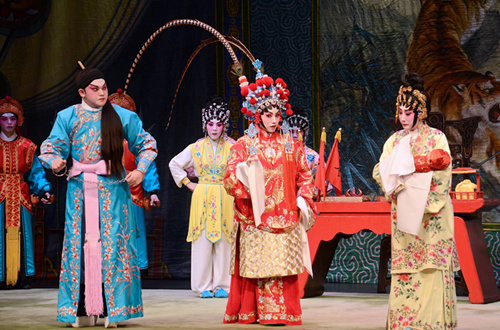Intangible cultural heritage in HK reflects both Eastern and Western cultures
Author : LIU HUI Source : Chinese Social Sciences Today 2017-07-10

Cantonese Opera is one of the best representatives of Hong Kong’s intangible cultural heritage, which was recognized by UNESCO’s list of world intangible cultural heritage in 2009.
Hong Kong leaves visitors with an impression of fast-paced lifestyles and modern development. However, it also has its hidden cultural gems.
Besides the Tsuen Wan Station of the Hong Kong subway network, a section of well-preserved old buildings are hidden under the towering skyscrapers. The Hakka Walled village of Sam Tung Uk silently showcases Hong Kong’s unique past.
Since June 2016, these historic pieces of architecture have become the core of the Hong Kong Intangible Cultural Heritage Center (HKICHC).
Sam Tung Uk is more than 200 years old and one of the oldest stone wall surrounded villages in Hong Kong history. In 1981, it was included on the list of declared monuments of Hong Kong. In 1987, it was refurbished as Sam Tung Uk Museum and officially opened to the public. Zou Xinghua, the curator of the museum, said that the reason why the HKICHC was established in Sam Tung Uk is because most examples of Hong Kong’s intangible cultural heritage are closely related to Hakka culture. The architectural style of Sam Tung Uk still has the traditional features of Hakka culture. Without exquisite, complex stone carvings, Sam Tung Uk reflects this culture in every detail. Elements such as the antithetical couplets written by inhabitants and hung in front of doors, lanterns and door-gods, reflect Hakka people’s philosophy of hard work and plain living. This philosophy dates back 200 years. The Hong Kong SAR government chose this location as a window to promote Hong Kong intangible cultural heritage.
With the development of Hong Kong’s economy and the changes in the urban landscape, intangible cultural heritage has become a significant cultural key word in Hong Kong in recent years. The preservation of intangible cultural heritage has turned into an important social phenomenon.
Since 2006, Zou has been engaged in the field of Hong Kong intangible cultural heritage. He thinks that Hong Kong’s intangible cultural heritage contains both Eastern and Western cultural characteristics and is full of variety.
At present, ten Hong Kong intangible cultural heritage items, including the Cantonese Opera, herbal tea, Cheung Chau Bun Festival and Tai O Dragon Boat Festival, have been successively listed on the national representative list of intangible cultural heritage. Cantonese Opera was included on UNESCO’s list of world intangible cultural heritage in 2009.
Zou said: “These ten items are the best representatives, but they’re just an example of Hong Kong’s intangible cultural heritage. The four-year-long general survey of Hong Kong intangible cultural heritage lists 480 items and covers all categories. Hong Kong’s unique political and economic environment and geographical location attracts immigrants from different places and preserves various traditional customs and cultures. Many items of cultural heritage, such as Cantonese Opera and Wing Chun Kungfu, were originally introduced from Chinese mainland, then developed and preserved in Hong Kong.”
In 2006, UNESCO’s Convention for the Safeguarding of Intangible Cultural Heritage formally went into effect in Hong Kong. And the SAR government immediately set up a working team for intangible cultural heritage, appointing local scholars, experts and community members to offer advice. In 2008, the consultative committee of intangible cultural heritage was officially established. The committee invited the Hong Kong University of Science and Technology to conduct the general survey and completed a list of Hong Kong intangible cultural heritage.
“The SAR government supports the protection of intangible cultural heritage in different ways, including setting up files, conducting research, preservation, promotion and inheritance. In Hong Kong, the government’s promotion, the non-governmental organizations’ response and academic institutions’ support are the three main powers involved in protecting intangible cultural heritage, ”Zou said.
Ye Shengtao made Chinese fairy tales from a wilderness
Ye Shengtao (1894–1988) created the first collection of fairy tales in the history of Chinese children’s literature...
-
How northern ethnicities integrated into Chinese nation
2023-09-18
-
Mogao caves
2023-09-12
-
Mogao Grottoes as ‘a place of pilgrimage’
2023-09-12
-
Time-honored architectural traditions in China
2023-08-29
-
Disentangling the civilizational evolution of China
2023-08-28
-
AI ethics in science fiction
2023-08-23














 2011-2013 by www.cssn.cn. All Rights Reserved
2011-2013 by www.cssn.cn. All Rights Reserved